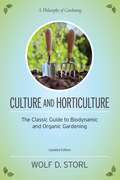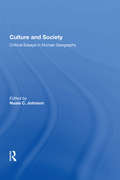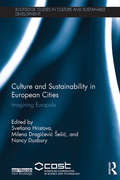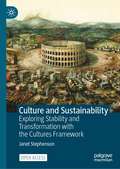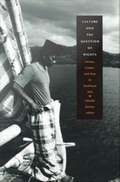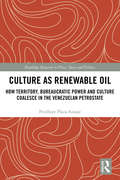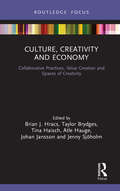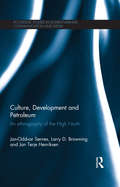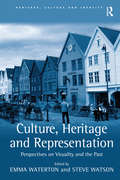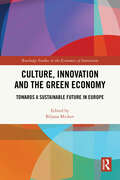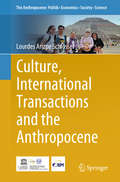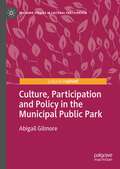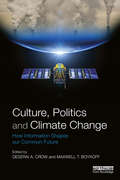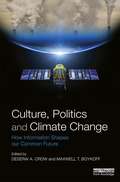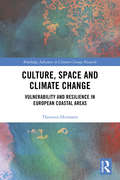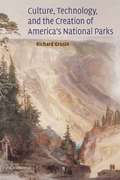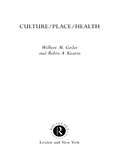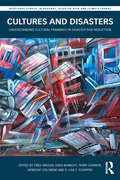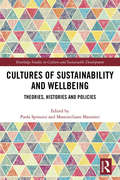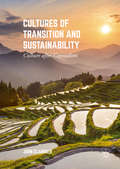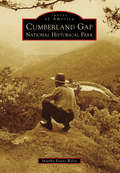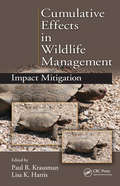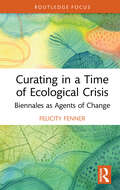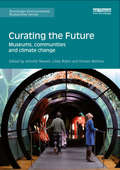- Table View
- List View
Culture and Horticulture: The Classic Guide to Biodynamic and Organic Gardening
by Wolf D. Storl Larry BergerVarious studies have shown time and again that small organic farms and home gardens are capable of producing more food per acre with less fossil energy than large-scale commercial agricultural installations dependent on machines and toxic chemical fertilizers and pesticides. This classic book by Wolf D. Storl, a respected elder in the practice of permaculture, details how food is grown holistically and beautifully by traditional communities around the world, and shows how to apply their ancient wisdom to our own gardens.With interest in natural, sustainable, organic and local food at an all-time high, people are looking beyond their farmers markets and CSA cooperatives to hyperlocal ways of growing healthy, delicious produce in urban gardens and their own backyards. Culture and Horticulture details time-tested methods that are as effective today as they were hundreds of years ago. On the practical front, the book works as a manual for creating and maintaining a bountiful harvest. It explains how to build the soil to maintain fertility; how to produce compost; how to plant, sow, and tend the various fruit and vegetable plants; how to rotate crops and practice companion planting; how to set up a favorable microclimate; how to deal with so-called weeds and pests; how to harvest at the right time; and finally how to store vegetables and herbs. Special emphasis is given to the art and science of composting, the compost being the "heart" of any self-sufficient garden and a model for the cycle of life, death, and rebirth.At the same time the reader is introduced to the wider aspects of horticulture, to its historical, philosophical, and cosmological contexts and social relevance. Gardening is a cultural activity, shaped by peoples' thoughts, wishes, and needs as well as by their cultural traditions. The author, an anthropologist by profession who has investigated the gardening practices of indigenous people throughout the world and worked for many years on biodynamic farms and in his own food garden, will introduce the reader to Rudolf Steiner's vision of the garden as an organic unit, embedded in the context of terrestrial and cosmic forces. Storl explains the importance of cosmic rhythms (solar, lunar, and planetary), the role of biodynamic herbal preparations as "medicines" for the garden organism, and the so-called "etheric" and "astral" forces. The book presents a vision of the garden as seen through the eyes of "Goethean science," a magical place where alchemical transformations of material substances take place.
Culture and Society: Critical Essays in Human Geography
by Nuala C. JohnsonHuman geographers have been at the forefront of research that examines the relationships between space, culture and society. This volume contains twenty-one essays, published over the past thirty years, that are iconic instances of this investigative field. With a focus on four broad themes - landscape, identity, colonialism, nature - these essays represent some of the best and most innovative interventions that geographers have made on these topics. From the visual to the corporeal, from rural Ceylon to urban America and from the sixteenth century to the twenty-first, this volume brings together a set of theoretically sophisticated and empirically grounded works.
Culture and Sustainability in European Cities: Imagining Europolis (Routledge Studies in Culture and Sustainable Development)
by Svetlana Hristova Nancy Duxbury Milena Dragićević ŠešićEuropean cities are contributing to the development of a more sustainable urban system that is capable of coping with economic crises, ecological challenges and social disparities in different nation-states and regions throughout Europe. This book reveals in a pluralistic way how European cities are generating new approaches to their sustainable development, and the special contribution of culture to these processes. It addresses both a deficit of attention to small and medium-sized cities in the framework of European sustainable development, and an underestimation of the role of culture, artistic expression and creativity for integrated development of the city as a prerequisite to urban sustainability. On the basis of a broad collection of case studies throughout Europe, representing a variety of regionally specific cultural models of sustainable development, the book investigates how participative culture, community arts, and more generally, creativity of civic imagination are conducive to the goal of a sustainable future of small and medium-sized cities. This is an essential volume for researchers and postgraduate students in urban studies, cultural studies, cultural geography and urban sociology as well as for policymakers and practitioners wanting to understand the specificity of European cities as hubs of innovation, creativity and artistic industriousness.
Culture and Sustainability: Exploring Stability and Transformation with the Cultures Framework
by Janet StephensonThis Open access book brings a cultural lens, and a distinctive analytical framework, to the problem of transitioning to a sustainable, low-carbon future. The world faces a seemingly impossible hurdle – to radically alter long-established social, economic and technological systems in order to live within the biophysical limits of the globe, while ensuring a just and enduring transition. The overarching premise of this book is that this cannot be achieved without widespread cultural change. ‘We need a change in culture’ is often used rhetorically, but what does this really mean?Stephenson starts by exploring culture’s elusiveness, describing its divergent interpretations before identifying core features of culture that are common across most definitions. These characteristics form the core of the cultures framework, an extensively tested approach to studying the links between culture and sustainability outcomes. The framework makes culture an accessible concept which can be analytically applied to almost any sustainability problem. Using many examples from around the world, Stephenson illustrates how cultural stability, cultural flexibility and cultural transformation all have a part to play in the sustainability transition. She guides the reader in the use of the cultures framework for policy development and to underpin research undertaken by individuals or by multi-disciplinary teams.Clearly and engagingly written, Culture and Sustainability is essential reading for academics, students, policy makers and indeed anyone interested in a sustainable future.
Culture and the Question of Rights: Forests, Coasts, and Seas in Southeast Asia
by Charles ZernerThis collection of ethnographic and interpretive essays fundamentally alters the debate over indigenous land claims in Southeast Asia and beyond. Based on fieldwork conducted in Malaysia and Indonesia during the 1980s and 1990s, these studies explore new terrain at the intersection of environmental justice, nature conservation, cultural performance, and the politics of making and interpreting claims. Calling for radical redefinitions of development and ownership and for new understandings of the translation of culture and rights in politically dangerous contexts--natural resource frontiers--this volume links social injustice and the degradation of Southeast Asian environments. Charles Zerner and his colleagues show how geographical areas once viewed as wild and undeveloped are actually cultural artifacts shaped by complex interactions with human societies. Drawing on richly varied sources of evidence and interpretation--from trance dances, court proceedings, tree planting patterns, marine and forest rituals, erotic poems, and codifications of customary law, Culture and the Question of Rights reveals the ironies, complexities, and histories of contemporary communities' struggles to retain their gardens, forests, fishing territories, and graveyards. The contributors examine how these cultural activities work to both construct and to lay claim to nature. These essays open up new avenues for negotiating indigenous rights against a background of violence, proliferating markets, and global ideas of biodiversity and threatened habitat. Contributors. Jane Atkinson, Don Brenneis, Stephanie Fried, Nancy Peluso, Marina Roseman, Anna Tsing, Charles Zerner
Culture as Renewable Oil: How Territory, Bureaucratic Power and Culture Coalesce in the Venezuelan Petrostate (Routledge Research in Place, Space and Politics)
by Penélope Plaza AzuajeThis book unpacks the links between oil energy, state power, urban space and culture, by looking at the Petro-Socialist Venezuelan oil state. It challenges the disciplinary compartmentalisation of the analysis of the material and cultural effects of oil to demonstrate that within the Petrostate, Territory, Bureaucratic Power and Culture become indivisible. To this end, it examines how oil is a cultural resource, in addition to a natural resource, implying therefore that struggles over culture implicate oil, and struggles over oil implicate culture. This book develops a story about Venezuela as an oil state and the way it deploys its policies to instrumentalise culture and urban space by examining the way Petro-Socialism manifests in space, how it is imagined in speeches and how it is discursively constructed in adverts. The discussion reveals how a particular culture is privileged by the Venezuela state-owned oil company and its social and cultural branch. The book explores to what effect the state-owned oil company constructs a parallel notion of culture that becomes inextricable from land, akin to a mineral deposit, and tightly controlled by the Petrostate. The book will appeal to researchers who are interested in Resource Management, Environmental Studies, Cultural Studies and Political Geography.
Culture, Creativity and Economy: Collaborative Practices, Value Creation and Spaces of Creativity (The Dynamics of Economic Space)
by Brian J. Hracs Taylor Brydges Tina Haisch Atle Hauge Johan Jansson Jenny SjoholmThis book nuances our understanding of the contemporary creative economy by engaging with a set of three key tensions which emerged over the course of eight European Colloquiums on Culture, Creativity and Economy (CCE): 1) the tension between individual and collaborative creative practices, 2) the tension between tradition and innovation, and 3) the tension between isolated and interconnected spaces of creativity. Rather than focusing on specific processes, such as production, industries or locations, the tensions acknowledge and engage with the messy and restless nature of the creative economy. Individual chapters offer insights into poorly understood practices, locations and contexts such as co-working spaces in Berlin and rural Spain, creative businesses in Leicester and the role and importance of cultural intermediaries in creative economies within Africa. Others examine the nature of trans-local cultural flows, the evolving "field" of fashion, and the implications of social media and crowdfunding platforms. This book will be of interest to students, scholars and professionals researching the creative economy, as well as specific cultural and creative industries, across the humanities and social sciences.
Culture, Development and Petroleum: An Ethnography of the High North (Routledge Studies in Environmental Communication and Media)
by Jan-Oddvar Sornes Larry Browning Jan Terje HenriksenThe discovery, just forty years ago, of vast oil and gas reserves in the Southwestern part of Norway, and more recently in the Arctic High North region, created an economic titan and posed a vast array of challenges for both the Norwegian government and the residents of this area. How to extract and transport all that oil and gas without despoiling the pristine environment? How to use this wealth in a socially responsible and sustainable way? How to prepare the rural High North citizens—traditionally fishermen and farmers—for a global, high-tech economy? Adopting an original narrative approach to qualitative research, this book tells the stories of 21 individuals either living or having a genuine interest in the High North, from mayors and entrepreneurs to farmers and fishermen. Through these first-hand meetings, it constructs an ethnographic study that reveals how petroleum and development have impacted on the regional economy and culture. This book will be of interest to all stakeholders in the oil and gas industry, and for students and scholars of organization studies, cultural and communication studies, environmental anthropology, natural resource management and sustainable development.
Culture, Heritage and Representation: Perspectives on Visuality and the Past (Heritage, Culture and Identity)
by Steve WatsonThe 'visual' has long played a crucial role in forming experiences, associations, expectations and understandings of heritage. Images convey meaning within a range of practices, including tourism, identity construction, the popularization of the past through a variety of media, and the memorialization of events. However, despite the central role of 'the visual' in these contexts, it has been largely neglected in heritage literature. This edited collection is the first to explore the production, use and consumption of visual imagery as an integral part of heritage. Drawing on case studies from around the world, it provides a multidisciplinary analysis of heritage representations, combining complex understandings of the 'visual' from a wide range of disciplines, including heritage studies, sociology and cultural studies perspectives. In doing so, the book provides a comprehensive overview of the theoretical and methodological tools necessary for understanding visual imagery within its cultural context.
Culture, Innovation and the Green Economy: Towards a Sustainable Future in Europe (Routledge Studies in the Economics of Innovation)
by Biljana MickovThe book offers a theoretical and practical analysis of the contemporary approach to art, culture and innovation, with special emphasis on the relationship between culture, innovation and the economy, in the context of green transition, as an indispensable sustainability factor.It presents new models that can be implemented, especially within strategic cultural planning, serving to ensure future development and attain certain levels of stability. The book argues that the cultural ecosystem should not be treated as merely a segment of the economy, but rather as a system that contains the economy. One of the main issues covered in the book is climate change. More than fifty years have passed since the first major conference of the United Nations (UN) on the Environment held in Stockholm in 1972, which gave birth to the “Stockholm Declaration”, and also cemented the global environmental movement. Thanks to Agenda 2030, the 17 Sustainable Development Goals and the Paris Agreement, there is an increased awareness of the dangers posed by climate change and of the need to switch to sustainable energy sources and a circular economy in the hope of preventing environmental problems that threaten life on Earth. Each chapter provides an accessible bank of knowledge on which existing theory and practice can be developed and new projects undertaken.The book adopts a highly interdisciplinary approach for open science, bridging theoretical insights with practical applications, and offers a comprehensive perspective that is both informative and actionable, so it can be used by academics, researchers, policy makers and cultural professionals for planning and development within the cultural sector.Biljana Mickov is a cultural researcher and professor. She holds a PhD from University of Reims Champagne - Ardeen.
Culture, International Transactions and the Anthropocene: Culture And Heritage In A Cosmopolitan World (The Anthropocene: Politik—Economics—Society—Science #17)
by Lourdes Arizpe SchlosserThis book analyses how global transactions have been progressively conducted and negotiated in the last 25 years. Achieving a new understanding of sustainability transition in the Anthropocene requires a deeper analysis on culture. The development of new positions of international institutions, national governments, scientific organizations, private fora and civil society movements on culture and nature shows how global transactions must take place in a rapidly transforming world. In her book the author provides a multi-situated ethnography of live debates on culture, global environmental change, development and diversity directly recorded by the author as a participating and decision-making anthropologist from 1988 to 2016. She examines the politicization and internationalization of culture by recognizing, negotiating and diversifying views on cultures and re-thinking culture in the Anthropocene. The merging of science and policy in taking up cultural and natural challenges in the Anthropocene is discussed.
Culture, Participation and Policy in the Municipal Public Park (Palgrave Studies in Cultural Participation)
by Abigail GilmoreThis book concerns the values and practices of participation in municipal public parks, and the connections they have with cultural policy, urbanism, and social life. Adopting a critical cultural policy lens, it identifies the park as a mundane but extraordinarily treasured place for the production and exchange of cultural values, regulation, resistance, and the practising of citizenship. Drawing on extensive mixed-methods research on everyday participation in diverse local cultural ecosystems in England and Scotland, the book examines the social lives of parks and their users, and the important public values that are generated through their common stewardship and usership. It presents case studies of parks and co-located museums as cultural public spheres, which promote both commoning and commodification. These are contextualized by histories of municipal parkmaking from the nineteenth century to the present and related to the making of local government and to other civic and cultural institutions.The book highlights contemporary issues of austerity, marketisation and de-municipalisation within local government in the context of urban development. It positions the public park as fundamental to democratic cultural governance and makes the case for the primacy of public trust, ownership, and park equity in safeguarding the right to the city.
Culture, Politics and Climate Change: How Information Shapes our Common Future
by Maxwell T. Boykoff Deserai A. CrowFocusing on cultural values and norms as they are translated into politics and policy outcomes, this book presents a unique contribution in combining research from varied disciplines and from both the developed and developing world. This collection draws from multiple perspectives to present an overview of the knowledge related to our current understanding of climate change politics and culture. It is divided into four sections – Culture and Values, Communication and Media, Politics and Policy, and Future Directions in Climate Politics Scholarship – each followed by a commentary from a key expert in the field. The book includes analysis of the challenges and opportunities for establishing successful communication on climate change among scientists, the media, policy-makers, and activists. With an emphasis on the interrelation between social, cultural, and political aspects of climate change communication, this volume should be of interest to students and scholars of climate change, environment studies, environmental policy, communication, cultural studies, media studies, politics, sociology.
Culture, Politics, and Climate Change: How Information Shapes our Common Future
by Maxwell T. Boykoff Deserai A. CrowFocusing on cultural values and norms as they are translated into politics and policy outcomes, this book presents a unique contribution in combining research from varied disciplines and from both the developed and developing world.<P> This collection draws from multiple perspectives to present an overview of the knowledge related to our current understanding of climate change politics and culture. It is divided into four sections – Culture and Values, Communication and Media, Politics and Policy, and Future Directions in Climate Politics Scholarship – each followed by a commentary from a key expert in the field. The book includes analysis of the challenges and opportunities for establishing successful communication on climate change among scientists, the media, policy-makers, and activists.<P> With an emphasis on the interrelation between social, cultural, and political aspects of climate change communication, this volume should be of interest to students and scholars of climate change, environment studies, environmental policy, communication, cultural studies, media studies, politics, sociology.
Culture, Space and Climate Change: Vulnerability and Resilience in European Coastal Areas (Routledge Advances in Climate Change Research)
by Thorsten HeimannWays of handling climate change vary worldwide. Differences can be observed in the perception of potential threats and opportunities as well as in the appraisal of adequate coping strategies. Collective efforts often fail not because of technical restrictions, but as a result of social and cultural differences between the actors involved. Consequently, there is a need to explore in greater depth those zones of cultural friction which emerge when actors deal with climate change. This book examines how cultural differences in the handling of climate change can be described and explained. The work develops the concept of culture as relational space, elaborates explanatory approaches, and investigates them by surveying more than 800 actors responsible for spatial development of the European coastal regions in the Netherlands, Germany, Denmark, and Poland. In doing so, this book engages with debates on cultural globalisation, in which the attachment of culture to place is increasingly being questioned. Adopting the approach of culture as relational space allows possible cultural formations to be examined across diverse fields of application from the local to the global scale. In addition, the book investigates how far different value orientations, beliefs, and identities can explain diverse perceptions of problems and opportunities right up to preferences for climate-mitigation and adaptation measures. Providing comprehensive insights into the diverse zones of cultural friction which scholars and practitioners face when handling climate change locally and globally, this book will be of great interest to those studying climate change, environmental sociology, and sustainable planning.
Culture, Technology, and the Creation of America's National Parks
by Richard GrusinRichard Grusin's innovative study investigates how the establishment of national parks participated in the production of American national identity after the Civil War. The creation of America's national parks is usually seen as an uncomplicated act of environmental preservation. Grusin argues, instead, that parks must be understood as complex cultural technologies for the reproduction of nature as landscape art. He explores the origins of America's three major parks--Yosemite, Yellowstone, and Grand Canyon--in relation to other forms of landscape representation including photography, mapping, travel writing, and fiction.
Culture/Place/Health (Critical Geographies #Vol. 16)
by Wilbert M. Gesler Robin A. KearnsCulture/Place/Health is the first exploration of cultural-geographical health research for a decade, drawing on contemporary research undertaken by geographers and other social scientists to explore the links between culture, place and health. It uses a wealth of examples from societies around the world to assert the place of culture in shaping relations between health and place. It contributes to an expanding of horizons at the intersection of the discipline of geography and the multidisciplinary domain of health concerns.
Cultures and Disasters: Understanding Cultural Framings in Disaster Risk Reduction (Routledge Studies in Hazards, Disaster Risk and Climate Change)
by Greg Bankoff Terry Cannon Fred Krüger Benedikt Orlowski E. Lisa SchipperWhy did the people of the Zambesi Delta affected by severe flooding return early to their homes or even choose to not evacuate? How is the forced resettlement of small-scale farmers living along the foothills of an active volcano on the Philippines impacting on their day-to-day livelihood routines? Making sense of such questions and observations is only possible by understanding how the decision-making of societies at risk is embedded in culture, and how intervention measures acknowledge, or neglect, cultural settings. The social construction of risk is being given increasing priority in understand how people experience and prioritize hazards in their own lives and how vulnerability can be reduced, and resilience increased, at a local level. Culture and Disasters adopts an interdisciplinary approach to explore this cultural dimension of disaster, with contributions from leading international experts within the field. Section I provides discussion of theoretical considerations and practical research to better understand the important of culture in hazards and disasters. Culture can be interpreted widely with many different perspectives; this enables us to critically consider the cultural boundedness of research itself, as well as the complexities of incorporating various interpretations into DRR. If culture is omitted, related issues of adaptation, coping, intervention, knowledge and power relations cannot be fully grasped. Section II explores what aspects of culture shape resilience? How have people operationalized culture in every day life to establish DRR practice? What constitutes a resilient culture and what role does culture play in a society’s decision making? It is natural for people to seek refuge in tried and trust methods of disaster mitigation, however, culture and belief systems are constantly evolving. How these coping strategies can be introduced into DRR therefore poses a challenging question. Finally, Section III examines the effectiveness of key scientific frameworks for understanding the role of culture in disaster risk reduction and management. DRR includes a range of norms and breaking these through an understanding of cultural will challenge established theoretical and empirical frameworks.
Cultures of Sustainability and Wellbeing: Theories, Histories and Policies (Routledge Studies in Culture and Sustainable Development)
by Massimiliano Mazzanti Paola SpinozziCultures of Sustainability and Wellbeing: Theories, Histories and Policies examines and assesses the interdependence between sustainability and wellbeing by drawing attention to humans as producers and consumers in a post-human age. Why wellbeing ought to be regarded as essential to sustainable development is explored first from multifocal theoretical perspectives encompassing sociology, literary criticism and socioeconomics, second in relation to institutions and policies, and third with a focus on specific case studies across the world. Wellbeing and its sustainability are defined in terms of biological and cultural diversity; stages of advancement in science and technology; notions of citizenship and agency; geopolitical scenarios and environmental conditions. Wellbeing and sustainability call for enquiries into human capacities in ontological, epistemological and practical terms. A view of sustainability that revolves around material and immaterial wellbeing is based on the assumption that life quality, comfort, happiness, security, safety always posit humans as both recipients and agents. Risk and resilience in contemporary societies define the intrinsically human ability to make and consume, to act and adapt, driving the search for and fruition of wellbeing. How to sustain the dual process of exploitation and regeneration is a task that requires integrated approaches from the sciences and the humanities, jointly tracing a worldwide cartography with clear localisations. This book will be of great interest to students and researchers interested in sustainability through conceptual and empirical approaches including social theory, literary and cultural studies, environmental economics and human ecology, urbanism and cultural geography.
Cultures of Transition and Sustainability: Culture after Capitalism
by John ClammerContending that culture lies at the root of our current planetary and civilizational crisis, this book uniquely explores the nature of the specifically cultural dimensions of that crisis and how culture relates to the areas of politics, policy, economics, ecology and the whole discourse of sustainability. It debates how profoundly our world is shaped by capitalist culture, emphasizing the import of political culture and policy, social justice, leadership and community in the shaping of a new cultural sustainability. It also reintroduces questions of religion, art, citizenship and comparative culture into the sustainability debate and suggests ways in which the central issue of consumer culture can be rethought and others in which socially satisfactory transitions to a sustainable future might be achieved. Addressing the specific role of culture in our crisis and of how to build cultural resources for transition, this cutting edge text provides the reader with an introduction to the literature on culture and sustainability, and both practical and theoretical tools for creating and advancing a humane and ecologically responsible future.
Cumberland Gap National Historical Park (Images of America)
by Martha Evans WileyBest known for its pivotal role in opening up the western frontier and its association with explorers and pioneers, the legendary Cumberland Gap has long been celebrated in music and literature. To better preserve that history, Cumberland Gap National Historical Park was authorized in 1940 and now covers more than 24,000 acres in Kentucky, Virginia, and Tennessee. Daniel Boone is remembered here, as well the Native Americans who used the path through the mountains for trade and warfare, the Civil War soldiers who took turns guarding this strategic portal, the geologists and industrialists who saw the potential for development, the businessmen who built one of the nation's first roads for automobile travel, and the displaced residents who gave up their homes for the park. The dream of a few dedicated individuals to one day restore the historic Wilderness Road through the Cumberland Gap came true in 2002 after decades of planning, and visitors can once again walk in the footsteps of the pioneers. Photographs spanning more than a century bring to life the fascinating stories and history of this pass.
Cumulative Effects in Wildlife Management: Impact Mitigation
by Paul R. Krausman Lisa K. HarrisAs humans continue to encroach on wildlands, quality and quantity of wildlife habitat decreases before our eyes. A housing development here, a shopping mall there, a few more trees cut here, another road put in there, each of these diminishes available habitat. Unless the cumulative effects of multiple simultaneous development projects are recogniz
Curating in a Time of Ecological Crisis: Biennales as Agents of Change
by Felicity FennerCurating in a Time of Ecological Crisis reaffirms the relevance and impactful role of art, revealing how contemporary art exhibitions can capture the zeitgeist and advance new and collaborative approaches to a more sustainable inhabitation of Earth. The book is largely focused on biennales, which it argues are the contemporary exhibition models with the greatest capacity to offer new perspectives and propose alternative ways of connecting with our social and natural environments. Felicity Fenner demonstrates this by showing how curators of these high-profile exhibitions are responding in creative and engaging ways to the issues that preoccupy artists and society more broadly, of which the ecological crisis is paramount. Drawing on case studies from different parts of the world, the author reveals how biennales can make a constructive contribution to debates and attitudes around climate change, and how the role of the curator has evolved to re-embrace a duty of care not just to art but to the natural world as well. Curating in a Time of Ecological Crisis investigates how large-scale exhibitions of contemporary international art can become agents of change. As such, the book will be essential reading for scholars, students, and practitioners with an interest in exhibitions, curating, contemporary art, and environmental sustainability.
Curating the Future: Museums, Communities and Climate Change (Routledge Environmental Humanities)
by Libby Robin Jennifer Newell Kirsten WehnerCurating the Future: Museums, Communities and Climate Change explores the way museums tackle the broad global issue of climate change. It explores the power of real objects and collections to stir hearts and minds, to engage communities affected by change. Museums work through exhibitions, events, and specific collection projects to reach different communities in different ways. The book emphasises the moral responsibilities of museums to address climate change, not just by communicating science but also by enabling people already affected by changes to find their own ways of living with global warming. There are museums of natural history, of art and of social history. The focus of this book is the museum communities, like those in the Pacific, who have to find new ways to express their culture in a new place. The book considers how collections in museums might help future generations stay in touch with their culture, even where they have left their place. It asks what should the people of the present be collecting for museums in a climate-changed future? The book is rich with practical museum experience and detailed projects, as well as critical and philosophical analyses about where a museum can intervene to speak to this great conundrum of our times. Curating the Future is essential reading for all those working in museums and grappling with how to talk about climate change. It also has academic applications in courses of museology and museum studies, cultural studies, heritage studies, digital humanities, design, anthropology, and environmental humanities.
Curating the Future: Museums, Communities and Climate Change (Routledge Environmental Humanities)
by Libby Robin Jennifer Newell Kirsten WehnerCurating the Future: Museums, Communities and Climate Change explores the way museums tackle the broad global issue of climate change. It explores the power of real objects and collections to stir hearts and minds, to engage communities affected by change. Museums work through exhibitions, events, and specific collection projects to reach different communities in different ways. The book emphasises the moral responsibilities of museums to address climate change, not just by communicating science but also by enabling people already affected by changes to find their own ways of living with global warming. There are museums of natural history, of art and of social history. The focus of this book is the museum communities, like those in the Pacific, who have to find new ways to express their culture in a new place. The book considers how collections in museums might help future generations stay in touch with their culture, even where they have left their place. It asks what should the people of the present be collecting for museums in a climate-changed future? The book is rich with practical museum experience and detailed projects, as well as critical and philosophical analyses about where a museum can intervene to speak to this great conundrum of our times. Curating the Future is essential reading for all those working in museums and grappling with how to talk about climate change. It also has academic applications in courses of museology and museum studies, cultural studies, heritage studies, digital humanities, design, anthropology, and environmental humanities.
